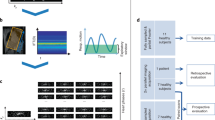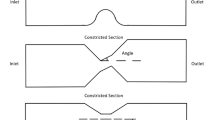Abstract
Systematic and random errors of MRI measurements in conjunction with the absence of ground truth data limit the assessment of accuracy and precision of 4D flow MRI image reconstruction and other downstream tasks. In this work, we propose to generate scalable synthetic CFD-enhanced aortic 4D flow MRI data, which we assemble into a dataset named RACLETTE. Our approach takes in-vivo 4D flow MRI data as input and pairs it with CFD-based “ground-truth” mean and turbulent flow fields. Specifically, high-resolution pulsatile velocity-vector and turbulent flow fields are simulated for varying degrees of aortic stenosis for a set of 139 time-resolved compliant aortic geometries. To generate realistic datasets, the synthetic flow fields are projected and embedded into the background of the in-vivo 4D flow MRI scans. Upon Fourier transform, data sampling using a given velocity encoding and undersampling scheme yields k-space data as input to deep-learning image reconstruction, segmentation and other downstream tasks. Since the synthetic 4D flow MRI data is paired with noise-free reference values including velocity, pressure, wall shear stress, the Reynolds stress tensor and pulse wave velocity, accuracy and precision of reconstruction and inference are readily available. To demonstrate the value of synthetic CFD-enhanced 4D flow MRI data, we utilize the dataset to train and apply (1) deep-learning based image reconstruction and (2) automatic vessel segmentation. It is shown that the synthetically trained deep-learning tasks generalize sufficiently and provide insights into the performance of reconstruction and processing tasks, indicating the potential value of our synthetic dataset also for further applications.
Access this chapter
Tax calculation will be finalised at checkout
Purchases are for personal use only
Similar content being viewed by others
References
Saitta, S. et al.: Evaluation of 4D flow MRI-based non-invasive pressure assessment in aortic coarctations. J. Biomech. 94, 13–21 (2019). https://doi.org/10.1016/j.jbiomech.2019.07.004.
Garcia, J., Barker, A.J., Markl, M.: The Role of Imaging of Flow Patterns by 4D Flow MRI in Aortic Stenosis. JACC Cardiovasc. Imaging. 12, 252–266 (2019). https://doi.org/10.1016/j.jcmg.2018.10.034.
Soomro, S., Akram, F., Munir, A., Lee, C.H., Choi, K.N.: Segmentation of Left and Right Ventricles in Cardiac MRI Using Active Contours. Comput. Math. Methods Med. 2017, 1–16 (2017). https://doi.org/10.1155/2017/8350680.
Zhuang, B., Sirajuddin, A., Zhao, S., Lu, M.: The role of 4D flow MRI for clinical applications in cardiovascular disease: current status and future perspectives. Quant. Imaging Med. Surg. 11, 4193–4210 (2021). https://doi.org/10.21037/qims-20-1234.
Binter, C. et al.: Turbulent kinetic energy assessed by multipoint 4-dimensional flow magnetic resonance imaging provides additional information relative to echocardiography for the determination of aortic stenosis severity. Circ. Cardiovasc. Imaging. 10 (2017). https://doi.org/10.1161/CIRCIMAGING.116.005486.
Markl, M., Frydrychowicz, A., Kozerke, S., Hope, M., Wieben, O.: 4D flow MRI. J. Magn. Reson. Imaging. 36, 1015–1036 (2012). https://doi.org/10.1002/jmri.23632.
Wiesemann, S. et al.: Impact of sequence type and field strength (1.5, 3, and 7T) on 4D flow MRI hemodynamic aortic parameters in healthy volunteers. Magn. Reson. Med. 85, 721–733 (2021). https://doi.org/10.1002/mrm.28450.
Vishnevskiy, V., Walheim, J., Kozerke, S.: Deep variational network for rapid 4D flow MRI reconstruction. Nat. Mach. Intell. 2, 228–235 (2020). https://doi.org/10.1038/s42256-020-0165-6.
Marlevi, D. et al.: Non-invasive estimation of relative pressure in turbulent flow using virtual work-energy. Med. Image Anal. 60, 101627 (2020). https://doi.org/10.1016/j.media.2019.101627.
Ferdian, E. et al.: 4DFlowNet: super-resolution 4D flow MRI using deep learning and computational fluid dynamics. Front. Phys. 8 (2020). https://doi.org/10.3389/fphy.2020.00138.
Dirix, P., Buoso, S., Peper, E.S., Kozerke, S.: Synthesis of patient-specific multipoint 4D flow MRI data of turbulent aortic flow downstream of stenotic valves. Sci. Rep. 12, 16004 (2022). https://doi.org/10.1038/s41598-022-20121-x.
Buoso, S., Joyce, T., Schulthess, N., Kozerke, S.: MRXCAT2.0: Synthesis of realistic numerical phantoms by combining left-ventricular shape learning, biophysical simulations and tissue texture generation. J. Cardiovasc. Magn. Reson. 25, 25 (2023). https://doi.org/10.1186/s12968-023-00934-z.
Hammernik, K. et al.: Learning a variational network for reconstruction of accelerated MRI data. Magn. Reson. Med. 79, 3055–3071 (2018). https://doi.org/10.1002/mrm.26977.
Oktay, O. et al.: Attention U-Net: Learning Where to Look for the Pancreas. (2018).
Buoso, S., Joyce, T., Kozerke, S.: Personalising left-ventricular biophysical models of the heart using parametric physics-informed neural networks. Med. Image Anal. 71, 102066 (2021). https://doi.org/10.1016/j.media.2021.102066.
Buoso, S., Manzoni, A., Alkadhi, H., Plass, A., Quarteroni, A., Kurtcuoglu, V.: Reduced-order modeling of blood flow for noninvasive functional evaluation of coronary artery disease. Biomech. Model. Mechanobiol. 18, 1867–1881 (2019). https://doi.org/10.1007/s10237-019-01182-w.
Yushkevich, P., Hao, J., Pouch, A., Ravikumar, S.: ITK-SNAP 4.0. http://www.itksnap.org/pmwiki/pmwiki.php.
Vishnevskiy, V., Gass, T., Szekely, G., Tanner, C., Goksel, O.: Isotropic Total Variation Regularization of Displacements in Parametric Image Registration. IEEE Trans. Med. Imaging. 36, 385–395 (2017). https://doi.org/10.1109/TMI.2016.2610583.
Ferdian, E., Dubowitz, D.J., Mauger, C.A., Wang, A., Young, A.A.: WSSNet: aortic wall shear stress estimation using deep learning on 4D flow MRI. Front. Cardiovasc. Med. 8 (2022). https://doi.org/10.3389/fcvm.2021.769927.
Romero, P. et al.: Clinically-driven virtual patient cohorts generation: an application to aorta. Front. Physiol. 12 (2021). https://doi.org/10.3389/fphys.2021.713118.
Nabeel, P.M., Kiran, V.R., Joseph, J., Abhidev, V. V., Sivaprakasam, M.: Local Pulse Wave Velocity: Theory, Methods, Advancements, and Clinical Applications. IEEE Rev. Biomed. Eng. 13, 74–112 (2020). https://doi.org/10.1109/RBME.2019.2931587.
Cuomo, F., Roccabianca, S., Dillon-Murphy, D., Xiao, N., Humphrey, J.D., Figueroa, C.A.: Effects of age-associated regional changes in aortic stiffness on human hemodynamics revealed by computational modeling. PLoS One. 12, e0173177 (2017). https://doi.org/10.1371/journal.pone.0173177.
Pirola, S. et al.: On the choice of outlet boundary conditions for patient-specific analysis of aortic flow using computational fluid dynamics. J. Biomech. 60, 15–21 (2017). https://doi.org/10.1016/j.jbiomech.2017.06.005.
Updegrove, A., Wilson, N.M., Merkow, J., Lan, H., Marsden, A.L., Shadden, S.C.: SimVascular: An Open Source Pipeline for Cardiovascular Simulation. Ann. Biomed. Eng. 45, 525–541 (2017). https://doi.org/10.1007/s10439-016-1762-8.
Baumgartner, H. et al.: Recommendations on the Echocardiographic Assessment of Aortic Valve Stenosis: A Focused Update from the European Association of Cardiovascular Imaging and the American Society of Echocardiography. J. Am. Soc. Echocardiogr. 30, 372–392 (2017). https://doi.org/10.1016/j.echo.2017.02.009.
Herrmann, S. et al.: Differences in Natural History of Low- and High-Gradient Aortic Stenosis from Nonsevere to Severe Stage of the Disease. J. Am. Soc. Echocardiogr. 28, 1270-1282.e4 (2015). https://doi.org/10.1016/j.echo.2015.07.016.
OpenFOAM Foundation Inc.: OpenFOAM v1806. https://www.openfoam.com/.
Myronenko, A., Xubo Song: Point Set Registration: Coherent Point Drift. IEEE Trans. Pattern Anal. Mach. Intell. 32, 2262–2275 (2010). https://doi.org/10.1109/TPAMI.2010.46.
Gatti, A.: pycpd, https://github.com/siavashk/pycpd.
Winkelmann, S., Schaeffter, T., Koehler, T., Eggers, H., Doessel, O.: An Optimal Radial Profile Order Based on the Golden Ratio for Time-Resolved MRI. IEEE Trans. Med. Imaging. 26, 68–76 (2007). https://doi.org/10.1109/TMI.2006.885337.
Weine, J., McGrath, C., Dirix, P., Buoso, S., Kozerke, S.: CMRsim –A python package for cardiovascular MR simulations incorporating complex motion and flow. Magn. Reson. Med. (2024). https://doi.org/10.1002/mrm.30010.
Acknowledgments
This work was supported by funding from the Swiss National Science Foundation, grant 325230_197702. Microsoft is acknowledged for providing computational resources on Microsoft Azure.
Author information
Authors and Affiliations
Corresponding author
Editor information
Editors and Affiliations
Ethics declarations
The authors have no competing interests to declare that are relevant to the content of this article.
Rights and permissions
Copyright information
© 2025 The Author(s), under exclusive license to Springer Nature Switzerland AG
About this paper
Cite this paper
Dirix, P., Jacobs, L., Buoso, S., Kozerke, S. (2025). Synthesizing Scalable CFD-Enhanced Aortic 4D Flow MRI for Assessing Accuracy and Precision of Deep-Learning Image Reconstruction and Segmentation Tasks. In: Fernandez, V., Wolterink, J.M., Wiesner, D., Remedios, S., Zuo, L., Casamitjana, A. (eds) Simulation and Synthesis in Medical Imaging. SASHIMI 2024. Lecture Notes in Computer Science, vol 15187. Springer, Cham. https://doi.org/10.1007/978-3-031-73281-2_15
Download citation
DOI: https://doi.org/10.1007/978-3-031-73281-2_15
Published:
Publisher Name: Springer, Cham
Print ISBN: 978-3-031-73280-5
Online ISBN: 978-3-031-73281-2
eBook Packages: Computer ScienceComputer Science (R0)





